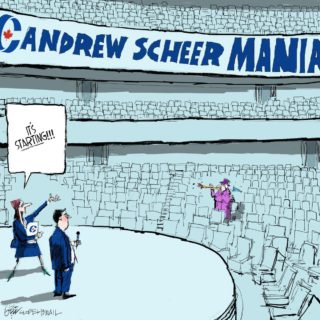Marieke Walsh and Kristy Kirkup report on the recent Liberal Party convention, held on the same weekend as the NDP convention. As the Liberals are currently leading in the polls, the authors address speculation that the goal is to prepare for an election, possibly later this spring or in the fall.
Given the current state of the pandemic and that many schools are now closed for in-person learning, this lesson is designed for both in-class and online collaborative learning. Senior students are to form online groups with fellow students, as directed by their teacher, or in-person, as the case may be. Individually, students in each group will take on one of the worksheet tasks, then share with the group. In this way, the lesson can be completed in a short time—likely less than a half-hour.
Subject Area(s) covered
Social studies, current events
New Terms to explain
Logistics, tenure
Materials Needed
Access to the article, and the Internet, especially:
Key things students can learn from this lesson
- Why Canadians may face an election this year;
- The name and a brief background of each the federal party leaders;
- Three key policy planks in a possible election platform of each party.
Action (here’s how we’ll do it)
Form groups of five students; each group will choose a leader who will read aloud to the group the attached article. All members are expected to take notes. After the reading, the group will discuss the article to determine:
- Some of the Liberal Party’s expected platform points—e.g., $100B for economic stimulus;
- Why the Liberals would not be ousted on a confidence vote, but would need to “pull the plug” themselves;
- The significance of Mr. Carney’s speech—who he is, his most recent foreign position and his last position while in Canada.
Next, assign each group member a link to one of the major party’s websites. They are to:
- Name the leader of the party, their last job before entering politics, and the length of their current tenure as leader;
- Name three of the party’s key platform issues–in the case of the NDP, based on their Convention agenda;
- Offer an opinion on what appealed or did not appeal to them on reviewing the website.
If time permits, a bonus: From this link, scan the registered political parties in Canada: https://www.elections.ca/content.aspx?section=pol&dir=par&document=index&lang=e
- How many are there in total?
- Were you surprised at that fact?
- Which ones caught your eye sufficiently for you to click on their information, and why?
When members have completed their tasks, have them report to the group, while the others take notes. They should review your notes and submit them to the teacher.
Consolidation of Learning
- The teacher takes up their reports after they have been evaluated.
Success Criteria
Students can:
- Explain why Canadians may face an election this year;
- List the names and a brief background of the leaders of each major federal party;
- List three key policy platforms for each federal party.
Confirming Activities
Students are able to offer informed comments on the election, when it’s announced, and describe their reasons for favouring any one party over another.
Helpful Internet Searches
- https://www.elections.ca/content.aspx?section=pol&dir=par&document=index&lang=e
- https://liberal.ca/our-platform
- https://www.conservative.ca/
- https://www.ndp.ca/
- https://www.greenparty.ca/en
- http://www2.blocquebecois.org/
Activities to do together
- When an election is called, discuss the leaders and the issues over meals, or when news items appear on media outlets;
- Get in touch with your local member of Parliament, and ask what they feel the key issues are for the next few years, and why.

